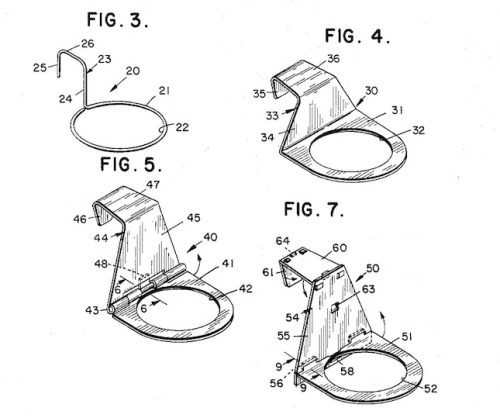
Engineering for the Love of Food (& Drinks)!
From Bon Appetit Magazine’s Twitter (@bonappetit)
On President’s Day—a.k.a. our national day of auto deals—we look at the history of the cup holder: bonap.it/XY4EOcImage Source (US Patent 2628054)
Ever since George Washington crossed the Delaware to go sign the lease on his new pickup truck (with 0 percent APR!), President’s Day has been associated with getting a good deal on a car. And while some people buy cars based on gas mileage or sporty looks, we all know that the most important parts of a vehicle are its cup holders.
They need to be plentiful, sturdy, and capable of holding any beverage ever created by man, preferably with those little spring-loaded gripper arms to keep your coffee or Big Gulp safe from pothole jostles. Cup holders aren’t just essential for our constant hydration, they’re also the source of our psychological well-being on the road: Clotaire Rapaille, a cultural anthropologist, has theorized that having warm liquid close by in the car brings our subconscious back to the safety of early childhood, and the food-love of our mother’s milk.
But cars weren’t always such happy places. In the dark days of early automotion, designers presumed that drivers would actually stop driving to eat or drink something, so cup holders had no place in interiors. From the get-go, though, aftermarket innovators sought to connect mobile Americans with food. If you were a Model T owner back in the ’20s, you were expected to modify your jalopy with as many doodads as you could afford to order from the Sears catalog, whose Ford gadget section, as E.B. White described it, “was larger than men’s clothing, almost as large as household furnishings.” You could add a flower vase to your dashboard, transform your car from a convertible to a hardtop, fiddle infinitely with the inner workings of your engine—and strap an entire kitchenette to the running boards, complete with a fold-out table and labeled compartments for flour meal, eggs, and ice water.
Real demand for the cup holder didn’t pick up until the 1950s, when drive-ins and drive-thru windows became mainstays of American eating. The very earliest evidence of complete cup-holding comes from a 1950 newspaper clipping that describes a “snack tray for car” that “hangs from dashboard.” The cups were held by metal discs hanging on chains from the tray, and seem to actually be fairly secure.
A few other ideas were floating around, too. Some were bad, like the Automobile Seat Article Holder, patented in 1953, which trusted a hinged plate wedged between the seat cushions to keep your drinks from sloshing around, but one Clyde W. Morgan of Dallas patented a precursor of the modern slide-out cup holder, the Refreshment Tray for Automobile Instrument Panel, which included two wells for beverages.
While inventors tried to fill the cup holder void, manufacturers started including proto-cup holders on the back of glove compartment doors (the earliest documented model with these is a 1955 Chevy). They weren’t anything more than little indentations in the plastic, unsafe for sipping at any speed, but they were a step in the right direction.
The best beverage security system of the era, though, belonged to the 1957 Cadillac Eldorado Brougham. Plenty of ultra-luxurious limousines had had built-in bars, but the Brougham was the first to come with a magnetized glove compartment door and a set of four metal tumblers, perfect for keeping your cognac stable while you’re passing the jitney on the way to the Hamptons.
In the ’60s, trays that would hook into the window well of the door became available, and were fairly commonplace as aftermarket accessories by the ’70s. Patents from the time exist for a more advanced version of Clyde W. Morgan’s pull-out tray, but customers looking for a car with a built-in cup holder were still stuck in the wilderness, or more likely in traffic, trying to turn left and shift into second while balancing their hot mugs of Sanka.
But that all changed in 1983, when Chrysler invented the minivan. The Dodge Caravan and Plymouth Voyager (which were the same car, for the most part) not only saved the company while creating a whole new category of car in the American market, they rolled off the assembly line with two serious cup holders in sunk into the plastic of the dashboard. In the next few years, more and more cars started including cup holders in their interior design—but it would take at least another decade for them to become ubiquitous.
In 1989, US News and World Report was still calling “crannies for drinking cups” an unnecessary “future frill,” but the life-or-death necessity of the cup holder was proven in the infamous 1994 lawsuit, Liebeck v. McDonald’s Restaurants. If you’re too young to remember the hot coffee case (or happened to spend that year renting a nice cave in the Poconos), Stella Liebeck, a 79-year-old woman, sued McDonald’s for damages after spilling 180-degree coffee on her lap in a stationary car. She got third-degree burns from the spill, and was awarded $2.7 million (reduced to $640,000 on appeal) by the jury. The case became fodder for endless Leno monologues and a national argument about tort reform, but it was also a strong argument for industry-wide adoption of the cup holder—if the car she’d been sitting in, her grandson’s Ford Probe, had had even one single cup holder, the whole ordeal might have been avoided.
Hope you all had a great President’s day, and some of us might have scored a Auto deal this past weekend! Do share if you did!
Source: http://thechefslab.tumblr.com/post/43553168236
Science, Engineering, History, Drink, Cupholder, BonApetit




No comments:
Post a Comment